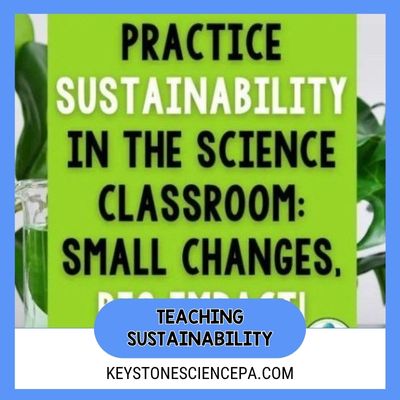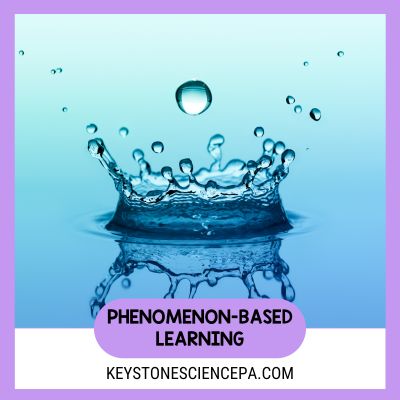Happy February, everyone! I am thrilled to have Jess from Spectacular Science write a guest blog this week for you on how to practice sustainability in the science classroom and how you can teach your students to practice sustainability in their own lives. Take it away, Jess!
Let’s face it—science classrooms can quickly turn into waste zones. From disposable plastics to stacks of unused paper, the environmental toll of our labs can be staggering. But as science educators, we hold a unique position to not only teach scientific concepts but to also lead by example, showing students how small, thoughtful actions can make a profound environmental difference. The great news? Practicing sustainability in your classroom doesn’t mean sacrificing hands-on learning. In fact, it opens up new opportunities for creativity, student engagement, and real-world problem-solving. Here’s how to practice sustainability in your science classroom and inspire your students to do the same!
1. Ditch the Single-Use Plastics
Plastic waste is one of the top offenders in our classrooms, but with a few mindful swaps, you can practice sustainability and drastically reduce your plastic footprint:
- Glass over plastic. Choose glass beakers, test tubes, and flasks instead of disposable plastic versions. They’re durable, reusable, and safer for long-term use.
- Save those containers! Old yogurt cups, takeout containers, and even plastic lids are perfect for reuse in experiments and storage—giving them a second life instead of sending them to the landfill.
- Water bottles over plastic cups. Set up a hydration station with a refillable water dispenser and encourage students to bring reusable bottles. Not only will this cut down on disposable cup waste, but it will also help your students stay hydrated during lessons!
Want to go deeper? Check out A Better Way to Teach Sustainability blog post for more tips on how to engage students with eco-friendly practices they can apply in their everyday lives.
2. Smarter Chemistry = Less Waste
Chemical waste is not only harmful to the environment but also potentially dangerous. You can minimize it by:
- Using micro-scale experiments. Replace large-scale reactions with smaller, more efficient versions that use less material—and still pack a punch in terms of learning outcomes.
- Going green with chemistry. Where possible, swap out harsh chemicals for natural alternatives. For example, use red cabbage as a pH indicator instead of synthetic options. It’s safe, effective, and a great opportunity for students to explore green chemistry and practice sustainability!
- Disposing of waste responsibly. Set up a designated station for hazardous waste disposal to keep your lab safe and environmentally responsible.
Want to take this further? The Environmental Chemicals and Their Impact on Human Health Lab is a hands-on way for students to learn about the effects of environmental chemicals and how to reduce their exposure.
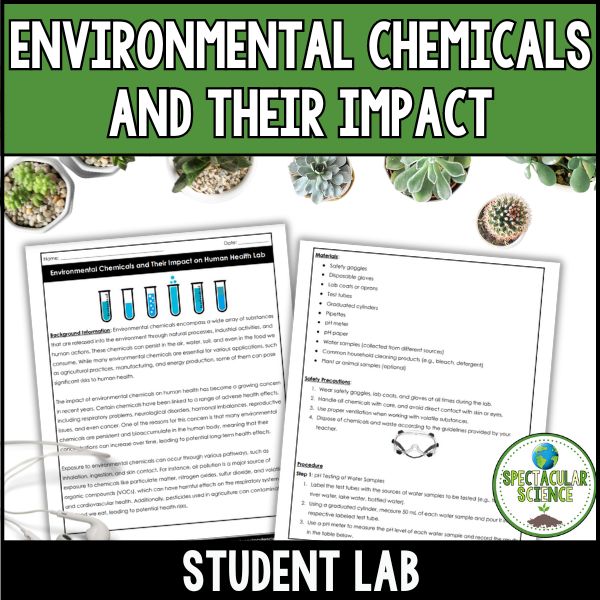
3. Reuse, Repurpose, Repeat
So much of the material we use in science labs can be repurposed with a little creativity! Try these hacks to practice sustainability in your classroom:
- Save and reuse supplies. Aluminum foil, glassware, and even scrap paper can be reworked into new experiments or projects.
- Set up a ‘reuse station.’ Create a space for students to return lightly used materials like test tubes and beakers, ready for the next round of experiments.
- Encourage creative repurposing. Need measuring cups? Silicone muffin cups make great alternatives! Organizing small parts? Those old film canisters are perfect.
- Repurpose old books or magazines. Have students cut out pictures or diagrams from outdated textbooks or magazines to use for class projects, posters, or visual aids. This prevents the need for new supplies while still promoting creativity.
- Upcycle discarded lab materials. Broken glassware or unused lab equipment can be upcycled into functional classroom decor or interactive learning tools, such as building a model of the solar system from old test tubes or creating a water filtration model from plastic bottles.
- Create a ‘scrap’ lab. Designate a small space where students can donate leftover materials from their experiments—think leftover string, fabric scraps, rubber bands, or pieces of wood. These can be used in future projects or reused for creative, hands-on learning opportunities.
- Use old textiles for experiments. Repurpose fabric scraps, old shirts, or linens as material for science demonstrations or experiments, such as testing fabric absorption in a lab on material properties or using worn clothing for demonstration of force and motion concepts.
By thinking outside the box and encouraging students to get creative, you’ll not only practice sustainability but also inspire problem-solving and resourcefulness in your classroom!
4. Practice Sustainability by Making it a Part of the Lesson
Your students can be part of the solution! Get them involved with:
- Eco-friendly lab challenges. Have students brainstorm sustainable alternatives to common lab materials.
- Experiments with a purpose. Have students build solar ovens from cardboard and aluminum foil, or test water filtration using natural materials. These hands-on activities not only teach science but also promote eco-conscious thinking. Click here to grab 30 engaging STEM activities that bring science to life in your classroom! This freebie includes a variety of hands-on lessons that help students apply real-world concepts while developing critical thinking and problem-solving skills. Plus, check out the 30 STEM Activity Ideas for your Middle and High School Science Classroom blog for even more sustainability-focused experiments and creative learning opportunities!
- Service-learning projects. The Environmental Science Service Learning Project helps students create real-world change by tackling environmental issues in their communities.
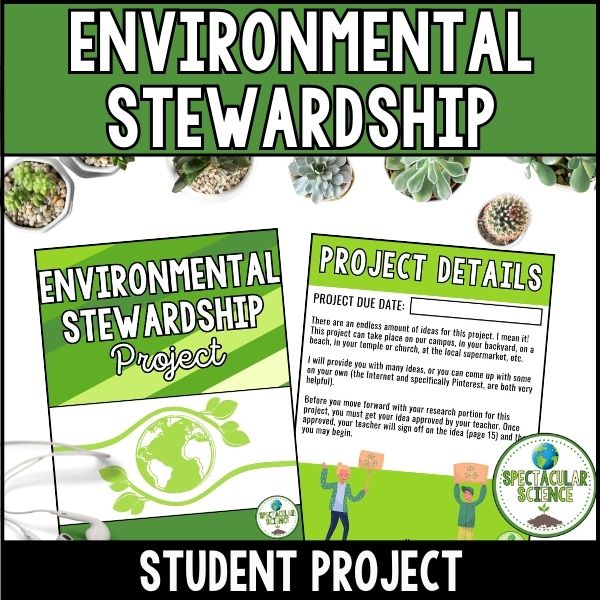
By incorporating these types of activities, you’ll help students make the connection between science, sustainability, and everyday problem-solving, all while encouraging them to think critically about how they can contribute to a more sustainable world.
5. Cut Down on Paper Waste
Paper waste can quickly pile up, but it’s easy to minimize with a few changes:
- Go digital. Use digital platforms like Google Classroom or interactive PDFs to cut down on printing. Your students will love the instant feedback and eco-friendly approach!
- Double-sided is the way to go. If printing is necessary, make the most of it by using both sides of the paper. You’ll reduce waste and save resources!
- Scrap paper bin. Set up a bin where students can donate or grab scrap paper for quick notes, calculations, or drawings. It’s a great way to repurpose, minimize waste and practice sustainability!
6. Create a Sustainability Culture
The best way to make sustainability stick is by cultivating a classroom culture around it. Here’s how to actively involve your students and set a lasting example:
- Talk about it. Open up discussions about the environmental impact of scientific practices, such as the use of chemicals, water, and energy. For instance, when conducting an experiment that requires heating, talk about the energy consumption and explore alternative energy sources like solar or wind power. You can also invite eco-conscious guest speakers who specialize in fields like renewable energy, environmental policy, or waste management to inspire students with real-world applications.
- Make it a class mission. Create a practice sustainability pledge with your students and set collective goals for the year. This can include actions like reducing classroom waste, conserving water, or transitioning to more eco-friendly materials. For example, challenge students to reduce paper waste by 50% by the end of the semester. Celebrate milestones with rewards like a “Green Science Lab” party or recognition for top eco-conscious student groups.
- Lead by example. Practice what you preach by demonstrating sustainable habits in the classroom. Compost organic waste from science experiments, such as plant matter from biology labs, and show students how composting helps reduce landfill waste and create nutrient-rich soil. Use rechargeable batteries in classroom devices and talk about their environmental benefits. If your school doesn’t already have a recycling program, lead the charge by setting up designated bins for plastic, paper, and metal, and teach students how to properly sort items.
- Incorporate sustainability into student projects. When assigning research projects or science fairs, encourage students to focus on sustainability topics. For example, they could design a low-waste version of an everyday product or research innovative ways to clean up ocean plastic. Giving students the freedom to explore sustainability in their own way fosters a sense of ownership and creativity around environmental issues.
- Host a sustainability challenge. Organize a class-wide sustainability competition where students track their waste reduction efforts. For example, they could track how much plastic they’ve avoided, how many reusable water bottles they’ve used, or how many eco-friendly transportation methods they’ve adopted (like biking or carpooling to school). The group with the most sustainable actions could win an eco-friendly prize, like a set of reusable straws or a plant for the classroom.
- Create a Green Science Lab Committee. Empower students to become sustainability leaders by forming a “Green Science Lab” committee. These students can be in charge of monitoring waste reduction efforts, educating their peers on eco-friendly practices, and organizing sustainability events, such as Earth Day clean-ups or a “zero waste” science fair. By assigning leadership roles, you give students a sense of responsibility and a chance to make a real impact.
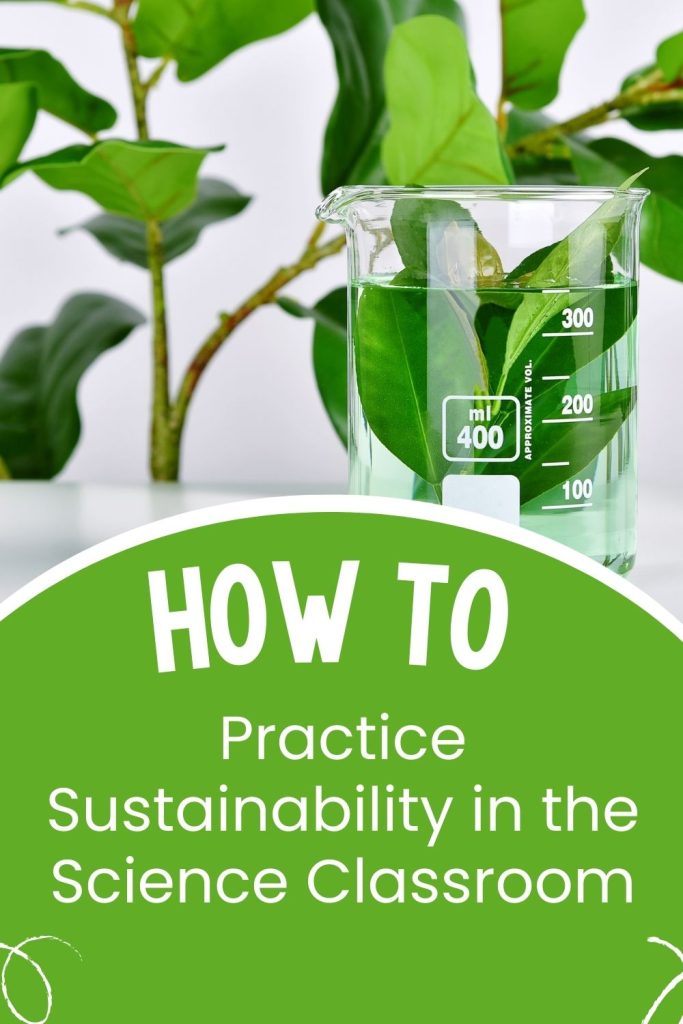
Every Little Bit Helps!
Practicing sustainability doesn’t have to be complicated—it’s all about making smarter choices. By incorporating just a few simple, intentional changes, you can reduce waste, conserve resources, and inspire your students to think like environmental scientists. Together, we can show them that small changes have a big impact, helping to create a greener, more sustainable future—one science lesson at a time!
Be Sure to Enter Our Giveaway
a Rafflecopter giveawaySustainability Resources from Keystone Science
Jess has a WEALTH of knowledge on teaching sustainability and has so many tips on how to practice sustainability in our classroom and at home. If you’re looking for other ways to practice sustainability check out my blog post on a sustainable classroom.
Let’s Connect!
💡Feel free to explore Keystone Science for ready-to-use high school biology & ecology NGSS aligned notes and activities.
💡Subscribe to my email list for weekly tips direct to your inbox.
💡Follow me on Instagram for daily tips, motivation, and facts you can use in your classroom!
🌟Share in the comments or email me directly 👉🏻 [email protected]







